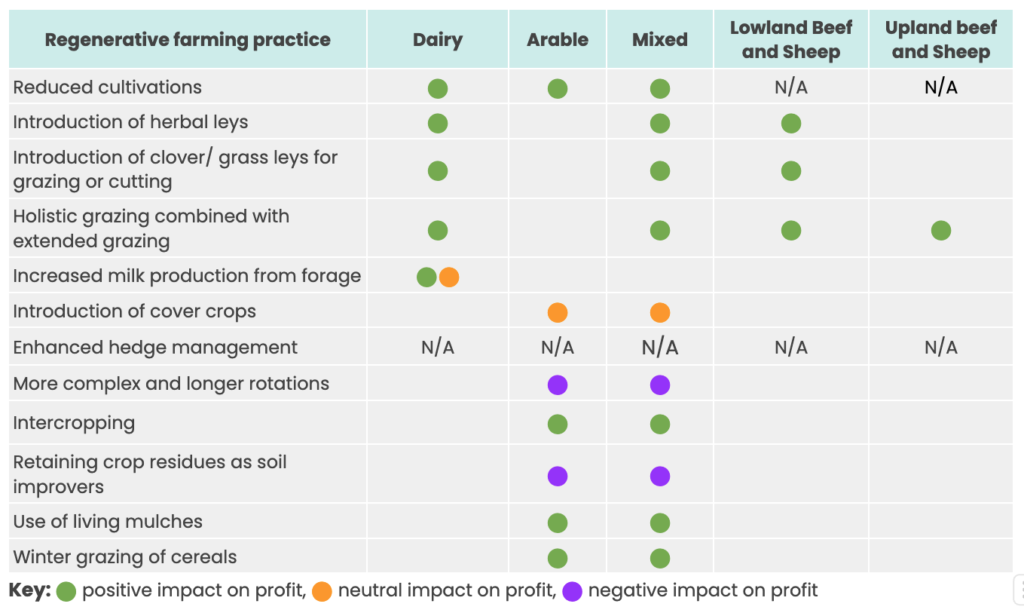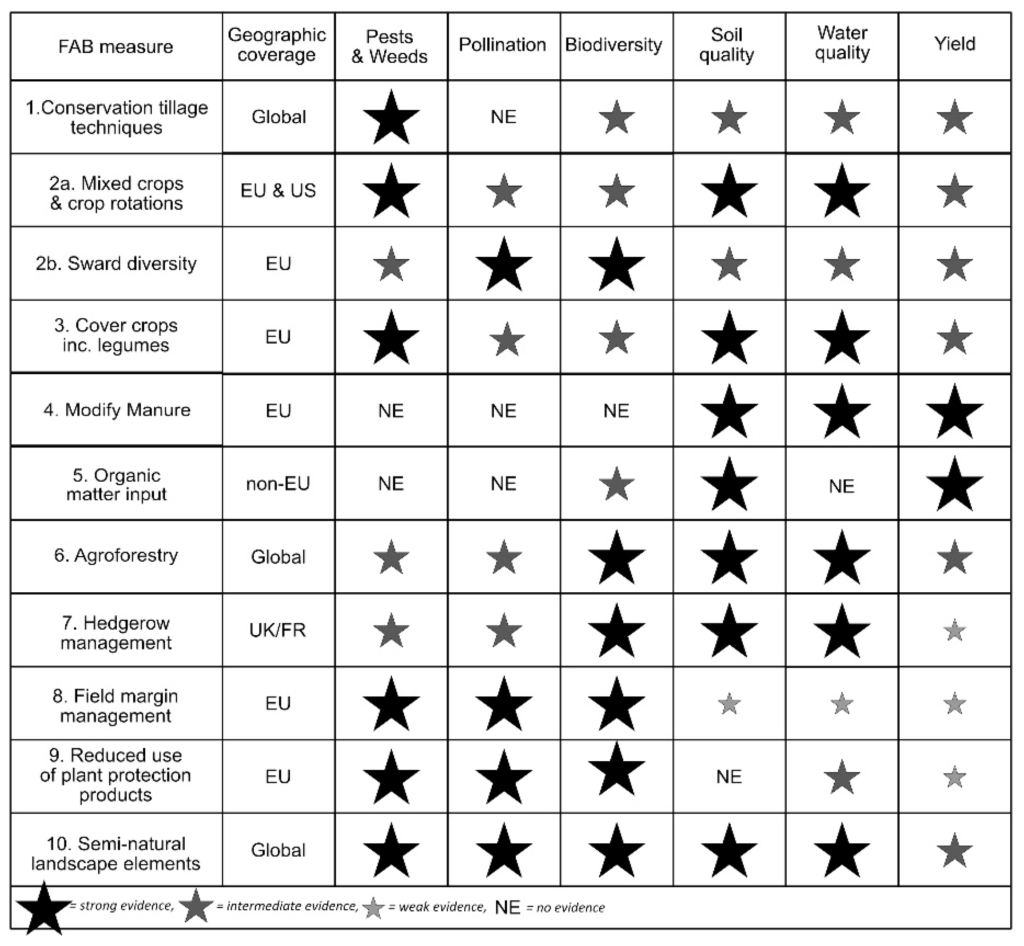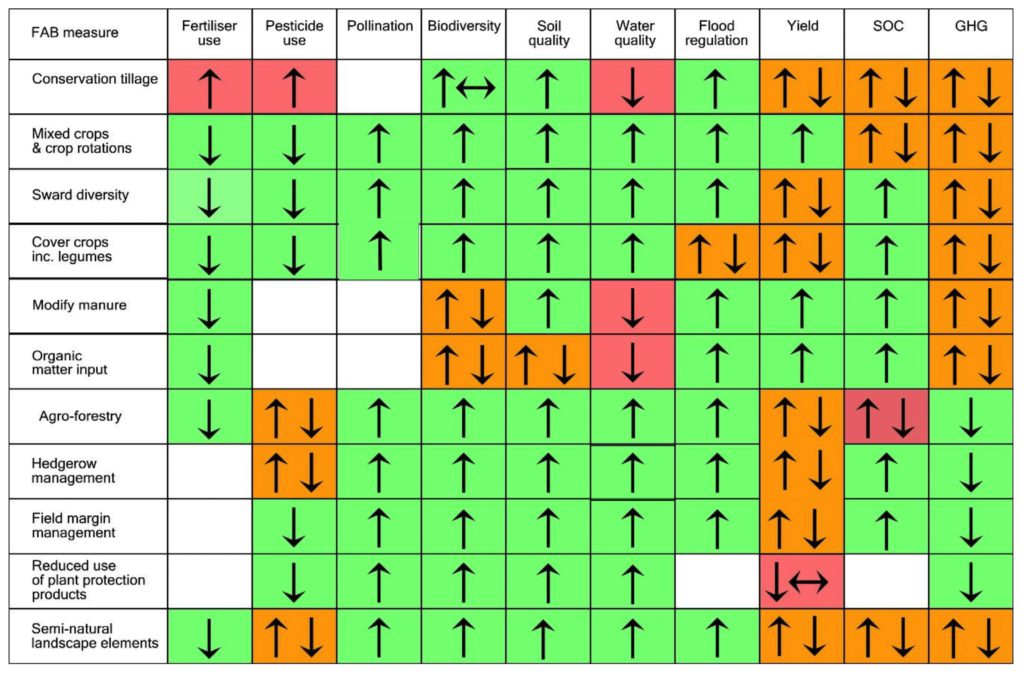
Recently, we completed a piece of work with SOS-UK that presented the financial and climate impacts of different regenerative farming practices, based on the best available evidence we could gather that relates to the UK. The full report is available here and over a series of three articles, we’ve outlined the need for more of this work, the current evidence on the impacts of regenerative farming practices – and in this final article – we share our overall conclusions from this work.
What did we find out?
Overall, from the financial partial budgeting we carried out, we found a potential for margins to be maintained if not improved, from the adoption of some of the regenerative farming practices we looked at. Mainly though, only if SFI payments are included where they could be available.

Typically, the adoption of more regenerative farming practices can result in lower yields, lower livestock stocking rates and lower output (without external support), especially where land is turned over to fertility building leys and reliance on artificial fertilisers is removed. Many studies in recent years have evidenced this, including the National Food Strategy. The extent of the challenge is unclear and from our assessment of the research; the current evidence base for any estimate on this is poor.
However, reducing input use can reduce business risk (vulnerability to input costs changes reduced with lower use). As more farmers learn how to implement more regenerative farming practices effectively the risk of reduced output will drop.
Confirming what is often cited anecdotally, there is also evidence that a transition period is required to allow soil and ecosystem health to improve so that it can function effectively with reduced or no chemical inputs. Depending upon the starting point, this can be up to five years, which highlights the need for support to bridge the financial gap, alongside other support for farmers as they acquire a new range of skills and knowledge. In England, the introduction of the Environmental Land Management Scheme provides financial support for the introduction of some key regenerative farming practices, such as growing cover crops and herbal leys. However, for more holistic changes to farming systems, such as moving to longer and more complex rotations including grass leys, it is less evident that the current financial support will facilitate this transition unless the farm has a profitable use for the grass and the individual crop gross margins are not compromised significantly.
There is also a cultural and social aspect to the acceptability of a transition to more regenerative farming systems which should not be underestimated. For instance, a more regenerative farm is often considered to be less “tidy”. Acceptability is increasing, especially where farmer networks exist to reinforce decision-making in favour of more regenerative farming practices.
Practices which reduce greenhouse gas emissions
In the previous article, we introduced some of the broad sustainability impacts of different regenerative farming practices. Specifically on greenhouse gas emissions, many of the recommended ways to reduce farm greenhouse gas emissions are part of the suite of more regenerative farming practices, e.g.
- Reducing the use of cultivations
- Reducing reliance on artificial fertiliser (which can only be achieved when other more regenerative farming practices are in place which support enhanced soil health and fertility)
- Changing feed sources for livestock away from reliance on imported protein sources such as soya- this is easier for ruminants than for young monogastrics
- Maximising use of forage for livestock feeding
Adopting these practices generally reduces the emissions per hectare, due to various factors such as reduced synthetic fertiliser and fuel use, improved soil health and more efficient use of resources. However, lower yields and lower livestock stocking rates are a trade-off and this will ultimately impact the carbon footprint of the end product unless any associated increases in soil carbon removal are factored in.
Typical, more regenerative farming practices include replacing fertiliser with legumes within cropping rotations and grassland; reducing cultivations for crop establishment; growing herbal leys; challenging received wisdom on the level of artificial fertilisers required by crops1 and the requirement for the use of insecticides. For livestock farmers, typical regenerative farming practices being adopted include reducing the use of supplementary feeds and keeping livestock grazing longer into the autumn, alongside practices to improve soil health and structure.
Financial viability of more regenerative farming practices
In our recent work with SOS-UK, we created partial budgets for the majority of the regenerative farming practices across a range of typical farm types: dairy, arable, mixed (non-dairy livestock and arable), lowland livestock and upland livestock.
In all budgets, costs were calculated on an annual basis. Input and sale values reflect prices in 2023 and are drawn from reliable industry sources. For future years the actual impact will be affected by changing prices and costs.
Whilst we are finding out more every year about the impact of many regenerative farming practices, which is helping to fill the information void, machinery manufacturers are also coming to market with improved equipment to enable some of the machinery linked regenerative farming practices such as reduced cultivation and intercropping/ companion cropping. These innovations are both reducing the cost (in some cases) for practice implementation and also improving the effectiveness of the practice itself.
A number of key issues surfaced which have a significant bearing on the introduction of these practices:
- Capital investment required: This is particularly relevant where specialist machinery and/or equipment is required. For instance, adopting minimum cultivations, intercropping and holistic grazing. For reduced cultivations, the need for more specialist drills is sometimes balanced by the ability to reduce the overall machinery inventory. In addition, Defra has made a capital grant available for some innovative items of machinery and equipment through the Countryside Productivity Scheme in the past, which reduces the initial capital required to adopt these practices. Other mechanisms to support access to appropriate machinery and equipment might be through machinery rings or syndicates or through third parties such as landlords underwriting the capital costs for these investments, or use of contractors.
- New technical skills required: It is clear that some practitioners have acquired the necessary skills to adopt regenerative farming practices with little or no yield penalty, which increases the financial viability of their adoption. As these skills become more common the adoption of these practices should increase. However, supporting a wider understanding of the skills and techniques required will accelerate adoption alongside an inherently better understanding of their financial viability.
- Linkage of the value of regenerative farming practices to the price of farm resources and inputs: Many of the regenerative farming practices described in our report involved a reduction in farming intensity. However, this can be difficult to implement when the cost of the key resources required (especially land) is high. There is no easy answer for this challenge, but many farmers will cite their need to finance their ongoing business to their adoption of more intensive farming practices, although external support for more sustainable farming is bridging this gap for some practices.
With support from SFI (in England), over 50% of the practices we budgeted show a neutral or positive financial impact, which is largely due to this support. The full report includes partial budgets for each practice together with the assumptions used to arrive at the budget outcome shown. It is intended that these budgets can be adapted to fit individual farm circumstances to enable farmers and growers to better estimate the impact of adoption on their holdings.
Recommendations
Our recommendations from this work are aimed at researchers, the Government and the industry itself:
- More research is required to provide clearer evidence of the impact of the adoption of regenerative farming practices on yield and output as this is seen as a key barrier to adoption by many farmers
- Increased support for farmers to build the confidence, skills and knowledge required for effective adoption of regenerative farming practices
- Institutional Landlords provide transition support to tenants undertaking a whole farm approach to the adoption of regenerative farming systems, especially where more complex and longer arable rotations are a central theme of the transition
- Support the development of Machinery Rings or Syndicates to facilitate access to the type of equipment required to facilitate the transition to more regenerative farming systems
Footnotes
- It has been estimated that £397 million of artificial fertiliser is wasted each year in the UK due to over-application. AHDB Research suggests UK farmers could potentially reduce up to 50% of the nitrogen fertilisers on specific crops without seeing a significant reduction in yield.






Recent Comments